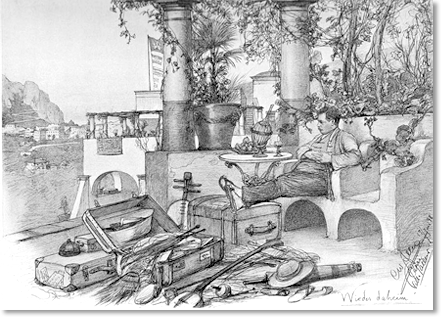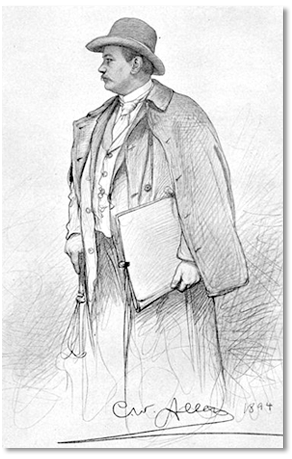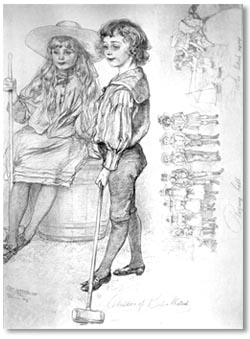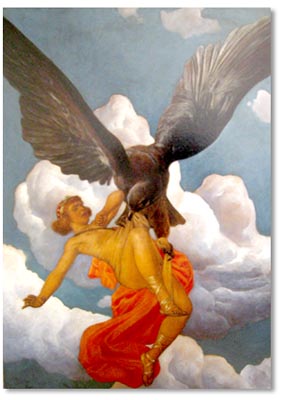

|
Back to |
| The Front Page |
| People |
|
The artist in exile
|
|
by Joern Vinnen with Bob Alman Posted December 2, 2010
|
The German artist born as Christian Wilhelm (C.W.) Allers was sufficiently successful as an artist and printmaker to finance the building of his own villa in Capri in the early 1890's. The villa became a well visited destination of prominent travelers. The island was long a favorite of artists and aesthetes escaping public censure and seeking freedom of expression. In 1903 a 4 1/2 year prison sentence was pronounced upon him in abstensia by a Naples Court in a homosexual scandal centering on the rich and powerful Krupp family of Germany industrialists. Many Allers paintings and drawings were thereafter signed with a pseudonym. For much of the last decade of his life he traveled the world painting the families of wealthy patrons. C.W. Allers books were well known in his time. Among his surviving work are meticulously detailed portraits of children playing croquet. This article is based on one of Allers' letters to an ancestor of Joern Vinnen, a great, great nephew of Allers and the founding chairman of the German croquet association.
Most of this article is told in Allers' own words, in the final letter he wrote to the publisher of some of his early books. The poignance of the letter is heightened by our knowledge that it was written in the last year of his life, while he was optimistically predicting a cure, covered in four cat skins to keep him warm, under the direction of his doctor.

|
Allers' last letter to Carl Griese
Karlsruhe, Südendstr. 6, June 7th, 1915
Dear Carl!
When will you visit me? During the summer holidays? I am not ready with my travel documents, since I've spent so much time "down under" side of the earth I have lost my German Reich citizenship. A while ago they canceled that silly law and I think now I can acquire nationality of Baden. In all the countries I visited you never required papers or a passport. You are always called by your Christian name, so I am "Willy", or you get a title, as in New Zealand, where I was known as Professor Andresen. As I've been out of military duty for almost 13 years, I didn't see the necessity for proper papers; often there were no German representatives or just Danish or English merchants.
If the World War hadn't begun, it would not have been necessary, but instead I was forced to stay in Basel when I had intended to go to Paris to do portraits of some minor barons and baronesses, which I had also done before, and then do some work in Den Haag, Amsterdam and London. But the war put an end to all of this, and I was even unable to travel from Switzerland to Germany without documents until the German Consul made a temporary arrangement and his wife asked me for a small Bismarck painting for an art bazaar in Basel to support the wives and children of German soldiers.

|
| Self portrait from 1898 |
With my huge experience in drawing I always finished within three short sessions, each up to 1 - 1¼ hours, and I delivered the paintings at a price of around 150 Marks, 7 to 10 pound, which was too cheap but nevertheless provided my travel budget with a good income. But in the few big cities in Australia and New Zealand, admirers of the fine arts were quickly served, yet no lasting customers could be raised such as those in towns like Hamburg or Berlin.
Sometimes I could do the work especially fast, e.g. if I lived in the homes of the customers. They sent a motor car to pick me up and I was driven 50 to 100 miles through the bush to the rich sheep farmers where I was recommended from one family to another and often made a whole genealogical gallery, from great-grandmother to a small baby. At the home of one family in New Zealand I made 25 portraits, in others 15 to 20. Once I broke a record, as the Englishmen say, by completing 21 portraits within 18 days. Well, this is something that makes you realize you how much you have done, but it was pleasant and all of them were carried out accurate, no modern scribbling, what is unacceptable as far as portraits are concerned.
You asked where I had been?

|
| Allers' drawings of croquet scenes sometimes feature the children of wealthy patrons in elaborate garb. He considered himself a naturalist and seldom suggested personal emotion in his art. |

|
In Christchurch I lived with a friend, the mayor for several years. We painted, took photographs and enlarged them together, played gramophone and croquet, fished for eels and many kinds of sea fish, and besides several portraits, I did a lot of other pictures, some of them in antique Pompeii style. In Australia I lived most of the time in Botany near Sydney and in Melbourne. But also at Hobart in Tasmania (Van-Diemens Land), where I spent a lot of time in the bush doing portraits, in the reality surrounded by huge, happy kangaroos, small wallabies, big poisonous snakes and Tasmanian Tigers, a type of tiger-hyena dog.
In South Africa, I visited Cape Town
In South Africa, I visited Cape Town and Durban in Natal several times, and went to Montevideo frequently too, as well as Rio de Janeiro in Brazil. I went around Cape Horn three times, once in a small English sailing ship, the "Letterewe", from Wellington to London in 120 days. In the South Seas, always on a small, leaking ship called "Tropic Bird", only about 250 tons and with a local crew from the Cook islands. We sailed and pumped from San Francisco through the whole of Oceania with a permanently merry crew from Aitutaki. Finally, all the leaks were stuffed, probably due to dirt or seaweed. The black cook did a good job, he even did Sauerkraut. Only one German seaman was on board, unfortunately he was washed overboard three days after our departure and drowned.

The Trojan youth Ganymede was the most attractive of all mortals, which prompted Zeus, in the form of an eagle, to abduct him for service as cup-bearer to the gods. This oil painting is signed "W. Andresen 1913," although it was done by Allers.
I traveled around the world eight or nine times, so I am a kind of "Flying Dutchman". I never denied being close to the sea. In Honolulu and San Francisco, Samoa, Sydney and New Zealand, I met with many of my old fellow marines. Some of them now as captains or as hoteliers, or as caraway or coconut planters, even copra shippers between the oceanic islands.
Now, I am at home in an unnatural rest, pasted and covered with plasters and newspapers and four cat skins, in order to keep some of the parts of my body at a high temperature. It's a new method developed by my physician, who declares he is acquainted with my illness and can heal me. On top of this I have rheumatism, all over my body, for which I am on a strawberry remedy. - Hope it will help, at least it tastes good.
So, now you know all about my traveling time.
It is wonderfully warm now, especially with the cat skins, but I am tropically trained.
Best regards to all of you
from Uncle Willy
A NOTE ON THE AUTHOR
Joern Vinnen, 43, helped to found Deutscher Krocket Bund in 1997 and since then has remained chairman of the German association. He frequently manages national championships and international test matches in Germany. He has a handicap of eight and loves to play Golf Croquet. Joern lives with his family in Hamburg and also plays croquet with them. As an attorney, he specializes in family and probate law.